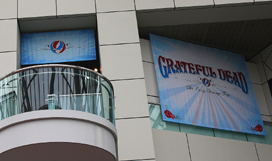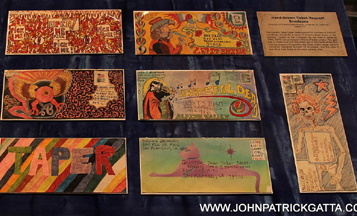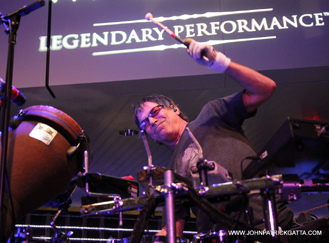Grateful Dead at the Rock Hall: A Report

You’ve got to hand it to those working with the Grateful Dead Archives at the University California Santa Cruz. They stand behind their words.
“When they took the collection from the Dead, in their first press release they wanted to work with organizations like us,” said Howard Kramer, Director of Curatorial at the Rock Hall. "When this opportunity came up, we called them and said, ‘We want to do this. Will you do it?’ And they said, ‘We said we would, so we will.’
With artifacts donated from UCSC, Grateful Dead Productions and individuals plus the band members’ collections and gear the result is the exhibit, “Grateful Dead: The Long, Strange Trip,” which fills two floors of the Rock and Roll Hall of Fame and Museum in Cleveland. It runs through December 2012.
Explaining how the Rock Hall and UCSC are able to open exhibits in the same year (UCSC will follow on June 29), Kramer said, “They have a massive amount of material. This doesn’t scratch the surface. I picked some great stuff but they still have more than enough to get going.”
“Long, Strange Trip” is broken into sections — an introduction of the members, the Dead as a songwriting, recording and touring entity, the relationship with fans and people who have been an integral part of the band’s career.
It includes finished and working manuscripts for songs ( “Truckin’,” “Box of Rain” and “Sugaree” ), handwritten notes from Dick Latvala, artifacts from Owsley “Bear” Stanley, promoter Bill Graham’s Father Time robe, the Grateful Dead Hotline answering machine, original artwork of album covers ( “Live Dead,” “Workingman’s Dead” and “Without a Net” ) and numerous instruments.
Although it contains Stanley Mouse’s “Cats Under the Stars” painting used for the Jerry Garcia Band album of the same name plus artwork for Robert Hunter’s “Tiger Rose” album and Garcia’s top hat from his Broadway run of shows, it doesn’t dwell on the members’ solo work.
“I felt that there was more than enough to cover in just the Dead’s career without going into the numerous solo projects and offshoots,” he said.
“Same with the post-Jerry thing. The exhibit is on the band, not all the other things the band members did. You can get lost down that rabbit hole very quickly and never do justice to any of it.”


Kramer credits the assistance and the vast amount of knowledge from Grateful Dead archivist David Lemieux and Grateful Dead archivist at UCSC Nick Meriwether for helping him over a nearly two-year period to obtain the right mix of items.
“This would not be the way it is. Those guys are essential.”
Both were in attendance at the exhibit’s opening night party.
Commenting on the final result, Lemieux said, "What makes the exhibit must-see to me is that they are exhibiting the primary artifacts, the actual items that were there with the band at the point of musical creation — Jerry’s Mac amp through which he literally played over 1,500 shows, lyrics that were created in the moment, mix notes from “Anthem of the Sun” with notations by Jerry and Phil demonstrating how orchestrated that album actually was, drums that Mickey played in concert, basses and guitars that Bob, Jerry and Phil played in concert including some very famous guitars (Bob’s pink guitar, the white Travis Bean from 1976-1977, etc.)."

Fortunate routing allowed the Mickey Hart Band to perform during the opening night celebration on the Rock Hall’s Main Stage. Due to recording the album, “Mysterium Tremendum,” the eight-member group showed a distinct tightness while still allowing the arrangements of several numbers the space to search for areas of sonic magic. The nearly two-hour set seamlessly fused album tracks such as “Supersonic Vision” and “Starlight Starbright” with Dead classics ( “Bertha,” “The Other One” and “Franklin’s Tower” ).
The concert experience with Mickey Hart Band relates to the intentions Kramer had for “Long, Strange Trip.” "With the Dead I wanted to tell the story in a way that people could understand; that these elements are all a part of the whole. It wasn’t, ‘Oh, the Grateful Dead played Woodstock. And they played Altamont. And they took acid back in ’65 with the Acid Tests.’ That’s not the important part. The important part is they created this music where spontaneity and creativity was the core of it.
“And it fed off American music — gospel, rhythm & blues, rock ‘n’ roll, country, bluegrass, folk — and moved to an audience that had this amazing spiritual connection and gave back to the band. All this information, all these activities culminated into the movement of the Grateful Dead as a touring act. That’s one of the things I want to get out there.”
After all the time spent, miles traveled and searches made to put it together, he admitted that everything acquired impressed him. “First of all, I have to qualify myself as a stupid music geek. So, I pay attention to a lot of stuff whether I like it or not because that knowledge attracts my attention. It’s that same shiny object. Whether it’s Lady Gaga or Beatles bootlegs, I’m paying attention.”

Pressed for specifics, Kramer pointed to the Dead’s pre-history. "We have Pigpen’s first guitar when he was a child. We have a handbill from Mother McCree’s Uptown Jug Champions at the Tangent in Palo Alto from May of 1964. We also have a handbill for this organization in Santa Cruz that presented folk music. It has all these performers like Jerry Kaukonen who, of course, is Jorma Kaukonen and David Landau who is David Frieberg of Quicksilver [Messenger Service]. And then there’s two little squares on the side of this flyer. One says “Guitar lessons”, one says “Banjo lessons” and on both of them it says “Jerry Garcia” and his phone number. Those are both ’64."
As a ‘music geek’, he’s most pleased at the opportunity to display the transformation of a song’s lyrics from early in its incarnation to what was finally recorded and then sung at a myriad of live concerts.
“The lyric manuscripts that they still have were pretty intense. The “Truckin’” manuscript is crazy because there’s a lot of work that went into that. You see the work that went into it on the page."
The Rock Hall had previously exhibited a different set of “Truckin’” lyrics that were once Robert Hunter’s, and featured an entire typed verse that was crossed out.
“That’s what separates bad artists from great artists. Self-editing. A difficult, difficult process. That’s why most artists are very bad producers of their own records. They need an editor.”

Rather than go deep into the Dead’s catalog, Kramer picked one of the band’s most commercial numbers specifically because it’s so well-known. "I want things to have resonance. If you’re gonna be an obscurist you’re not going to be doing any service to the visitor, to the artist, to the fan experience.
“My job is to create exhibits and be able to tell a truthful, honest story. And that’s what my goal is. I’ve done exhibits on a number of artists who I’m not particularly fond of, but I don’t think you could ever tell. I’m not going to be snarky about it in the exhibit. That’s not my place. My job is to represent them in the best possible way historically.”
Just like the motto that a Grateful Dead show was a place full of friends you haven’t met yet, his intention was to create an exhibit that could be embraced by everyone from longtime Deadheads to those with only a vague knowledge of the group’s lasting and influential musical legacy.
“Even if you’re not a fan of the Grateful Dead you’re gonna come away with a better idea of what their story is, not a linear story, but their whole zen.”



















